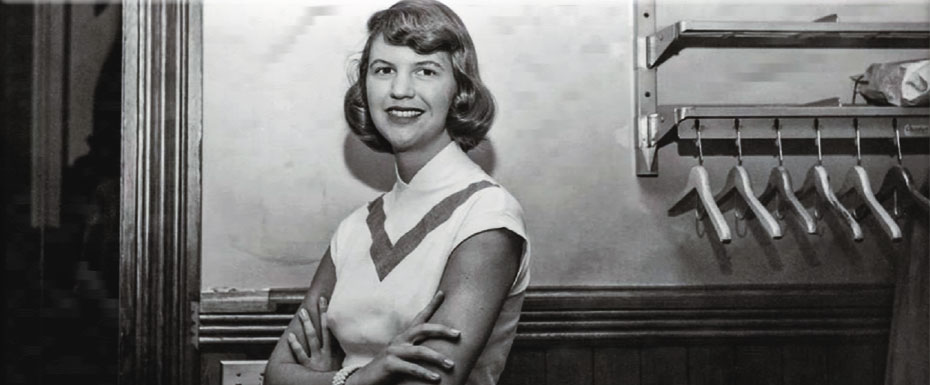
For many younger poets, especially women, Sylvia Plath’s works have become a model of what poetry can consist of, namely her writing, freely expressing everyday experiences, and speaking openly about things that were not allowed to be talked about until recently. Sylvia wrote about family problems, mental health issues, and sexuality – these themes were the origins of the new confessional poetry, which developed so powerfully in the following years. It was Sylvia Plath who became internationally associated with twentieth-century American poetry. The modern American poem, on the outside, should be primarily confessional, talking about everything that is silent – and it was Plath who essentially created this genre of American poetry.
Biography
Sylvia was born in Boston in a Unitarian family of Austrian-German descent. Her father, who suddenly died when she was less than ten years old, was a biology professor at Boston University. At a relatively early age, Plath began to suffer from a severe depressive disorder, which led to several suicide attempts (the last of which was successful). As a result, she received various forms of psychotherapy and medication, even electroconvulsive therapy. After her first course of treatment, she was able to return to college at Boston University and write her thesis on the figure of the double in the works of Dostoevsky. The thesis was defended with honors, which allowed the poetess to receive a Fulbright scholarship and study at a college in Cambridge, where she met her future husband, the British poet Ted Hughes.

After returning to the United States with her husband, Plath dropped out of college, though she continued to attend Robert Lowell’s creative writing seminars. These seminars were also attended by another confessional poet, Ann Sexton, who, along with Lowell, played a crucial role in Plath’s further formation as an author. Plath and Hughes soon returned to Britain, followed by new moves, new attempts at therapy with a psychoanalyst, and an increasingly deteriorating relationship with Hughes that ended in a breakup, all of which would become the subject of her later poems.
Immediately after the breakup, she entered a very productive period: the poems she wrote then made up the poetess’ posthumous and most notable collection entitled Ariel. Also, during this period, a novel called “The Bell Jar” was written – but this intensely creative period was followed by a new episode of depression and a new suicide attempt, this time a successful one. Plath’s executor was her husband Hughes, and he had an ambiguous role in Plath’s posthumous history: some of his ex-wife’s manuscripts were destroyed by him, and another part was banned from publication – the relationship between them was not improved even after Plath’s death.
Context
Plath is credited with confessional poetry, a movement of American literature formed in the 1960s, one of whose fathers were Robert Lowell – a professor from Boston University. However, in her youth, her favorite poet was the Welsh writer Dylan Thomas, who wrote hermetic, Christian-allusive poems. Plath’s husband was Ted Hughes, a British poet whose first steps in literature were supported by Thomas Eliot himself. Yet it is hard to find more dissimilar writers than Plath and Hughes: while the former strove for coded writing that reworked everyday life events, and the latter created poetry full of cultural references, almost allegorical.
The formation of the poetess’ recognizable style is completed after meeting Robert Lowell, and Ann Sexton – Plath became close to them after returning to Boston. They encouraged the poetess to reflect directly in her poetry the experience of depression, just as Lowell did in some of his poems.

Poetics
Sylvia Plath’s poems are built through the layering of meaningful allusions that refer to personal experiences, associations, and connections known only to the author. This is a characteristic of confessional poetry, but in Plath’s works, it is perhaps most clearly expressed. This poetry is opaque to the reader who is unaware of her biographical context (although now that Plath’s entire legacy is published and the context can be restored). Still, knowledge of it is not so necessary. The poems are meant to act empathetically, evoke those, usually mixed, feelings that the poetess herself suffered, to feel a similar psychological condition. In a sense, this is manipulative poetry: it seeks to capture the whole and make you empathize with the poetess herself, but it avoids directly specifying what it is that should cause such empathy.
Influence
It could be said that all subsequent poetry produced by women writers in a confessional manner is directly related to Plath’s works. She was the one who showed that the least comfortable and least “decent” subjects were the most poetic and that existential experience is ultimately more important than poetic technique.
Her attempt to make her mental state a subject of poetry was also crucial to the subsequent development of literature. She contributed significantly to the rethinking of how psychiatry works and the influence of mental states on creativity (most notably, it describes the novel called “The Bell Jar,” which came to prominence after the poetess’ death). Plath is one of the most widely read American authors, to the point that her name and image have become a password for all kinds of people.





